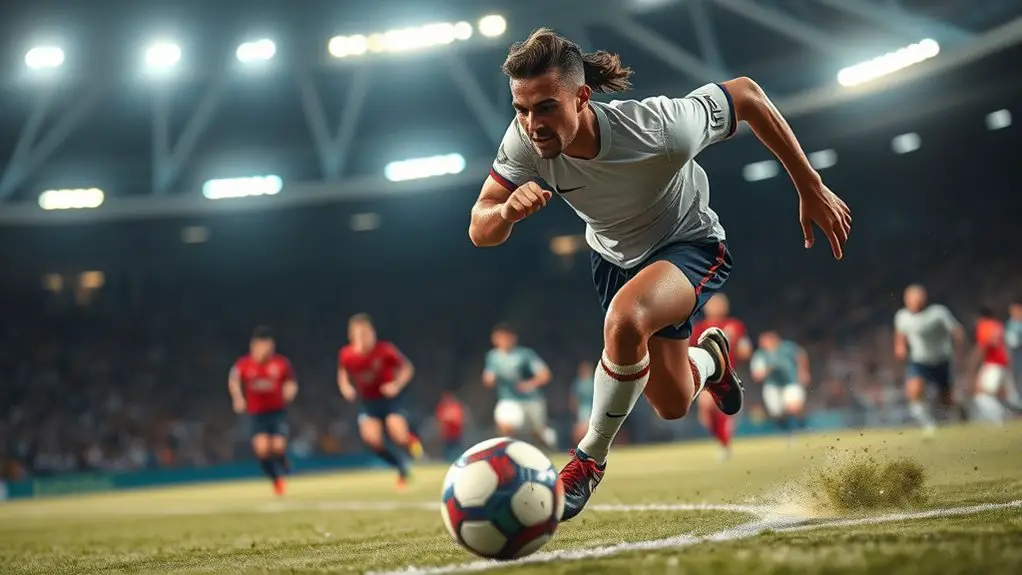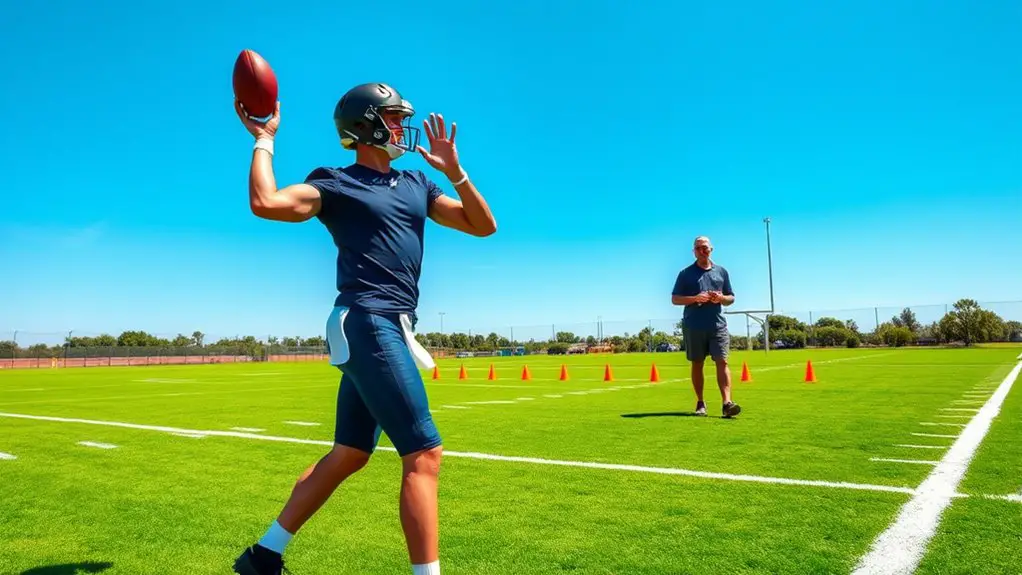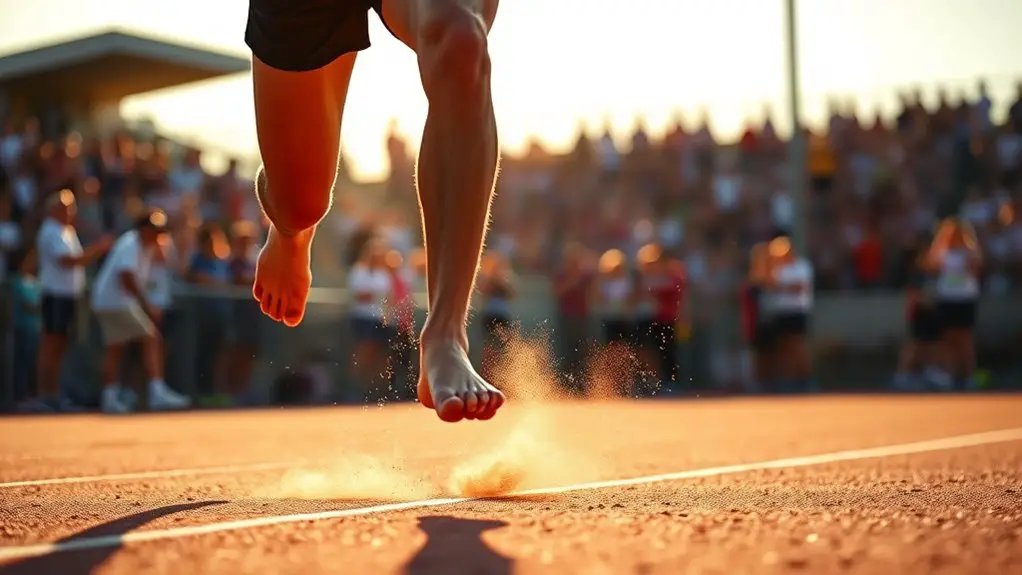Sprint speed plays an essential role in soccer performance, helping you outpace defenders and exploit gaps in their formations. It allows for quick changes from defense to attack and opens space for teammates. To maximize your sprinting potential, focus on interval training and plyometric exercises. Effective sprint techniques not only enhance your game but also contribute to injury prevention. There's so much more to explore about enhancing your speed and its impact on performance.
Understanding Sprint Speed in Soccer
When it comes to soccer, sprint speed is often one of the key factors that can set players apart. You know that blazing speed can take your game to the next level, enabling you to outrun defenders and create scoring opportunities. To harness that potential, you'll want to focus on sprint training, which helps you develop the explosive power needed for those quick bursts on the field.
But it's not just about raw speed; you also need speed endurance to maintain your pace throughout the match. That means building stamina while still being able to sprint effectively. Incorporating interval training into your routine can help you achieve this balance, allowing you to sprint, recover, and repeat. Additionally, focusing on acceleration techniques can further enhance your ability to explode off the line during critical moments of the game.
Ultimately, understanding and improving your sprint speed can give you the freedom to express your skills, dominate the game, and leave your mark on the field. Embrace the challenge, and watch your performance soar!
The Impact of Sprint Speed on Attacking Play
While some players rely on technical skills and tactical awareness, sprint speed can be the game-changer in attacking play. When you've got that burst of speed, you can exploit gaps in the defense and create opportunities others might miss. It allows you to stretch the backline, forcing defenders to make quick decisions, often leading to mistakes.
Incorporating speed into your attacking strategies gives you a massive edge. Think about how you can make those darting runs behind the defense or quickly shift from defense to offense. Speed advantages can also open up space for teammates, making it easier for them to find scoring chances. Additionally, interval training for endurance enhances your overall speed and stamina, allowing you to maintain that explosive pace throughout the match.
Sprint Speed and Defensive Strategies
When you think about defensive strategies, sprint speed plays a vital role in how effectively you can mark opponents. Fast defenders can close gaps quickly, making it harder for attackers to find space. Plus, that same speed opens up counterattack opportunities, turning defense into offense in the blink of an eye.
Impact on Marking Efficiency
Although sprint speed is often celebrated for its offensive advantages, it also plays an essential role in enhancing marking efficiency for defenders. When you can adjust your speed effectively, you're better equipped to apply marking techniques that keep attackers at bay. Here's how sprint speed impacts your defensive game:
- Tighter marking: Faster sprinting allows you to stay close to your opponent, reducing their space to maneuver.
- Quick recoveries: If you lose position, your speed helps you recover quickly, avoiding costly gaps in defense.
- Anticipating plays: A quick burst can let you read the game better, giving you the edge to intercept passes.
Counterattack Opportunities Created
Sprint speed not only enhances your marking efficiency but also creates valuable counterattack opportunities. When you possess that speed advantage, you can exploit gaps in the opponent's defense, turning defensive plays into offensive chances. This freedom allows you to initiate counterattack tactics effectively, catching defenders off-guard and creating scoring opportunities.
| Counterattack Aspect | Impact of Sprint Speed |
|---|---|
| Change Speed | Quick recovery and movement |
| Defensive Gaps | Exploiting spaces swiftly |
| Scoring Chances | Increased goal-scoring potential |
Utilizing your sprint speed not only boosts your game but also empowers your teammates, leading to dynamic and unpredictable gameplay. Embrace that speed, and watch the game open up for you and your team!
The Role of Acceleration in Game Dynamics
Acceleration plays an essential role in shaping game dynamics, as it directly influences a player's ability to respond to fast-paced situations on the field. When you master acceleration techniques, you can create a significant edge over your opponents.
Consider these key aspects:
- Quick Direction Changes: Your ability to accelerate allows for sharp turns, making it tough for defenders to predict your moves.
- Explosive Starts: A strong initial burst can help you seize scoring opportunities before defenders can react.
- Effective Counterattacks: Quick acceleration metrics can propel your team into a fast counterattack, catching the opposition off-guard. Additionally, incorporating plyometric exercises can further enhance your explosive power, leading to improved acceleration on the field.
Training Techniques to Enhance Sprint Speed
To boost your sprint speed, incorporating plyometric exercises can make a significant difference in your performance. These drills not only improve your explosive power but also enhance your sprint mechanics, leading to quicker acceleration on the field. Additionally, focusing on functional strength through compound movements will further support your sprinting capabilities. Let's explore how these techniques can elevate your game.
Plyometric Exercises Benefits
Plyometric exercises can be a game-changer for enhancing your sprint speed on the soccer field. By incorporating these dynamic movements into your training, you'll experience significant plyometric benefits that can elevate your performance. These exercises focus on quick and explosive movements, revealing your body's potential for faster sprints.
- Boosts explosive power, allowing for quicker starts and sharper acceleration
- Improves muscle elasticity, enhancing overall responsiveness during play
- Increases agility and coordination, giving you an edge over defenders
Embrace plyometric training, and you'll not only see improvements in your sprint speed but also gain confidence in your abilities. So, step outside your comfort zone, and let your natural athleticism shine on the pitch!
Sprint Mechanics Drills
Mastering sprint mechanics is essential for any soccer player looking to enhance their speed on the field. You'll want to incorporate various sprint drills and speed techniques to improve your performance. Here are some effective drills you can try:
| Drill Name | Focus Area | Benefits |
|---|---|---|
| A-Skip | Leg drive | Boosts coordination |
| B-Skip | Hip extension | Increases stride length |
| High Knees | Knee lift | Improves overall speed |
Incorporating these drills into your training routine can give you that extra edge. Remember, consistent practice will refine your mechanics and help you release your full sprinting potential on the pitch. Embrace the freedom of movement and watch your speed soar!
The Relationship Between Sprint Speed and Injury Prevention
While players often focus on enhancing their sprint speed to improve performance, it's equally important to recognize the role of speed in injury prevention. Studies show that higher sprint speed can reduce the likelihood of injury by allowing players to evade tackles and avoid high-impact situations. By training your sprinting technique, you can also strengthen your muscles, which plays a vital role in injury statistics. Additionally, incorporating proper warm-up techniques can significantly reduce the risk of hamstring injuries, ensuring optimal muscle functionality.
Enhancing sprint speed not only boosts performance but also plays a crucial role in injury prevention.
To enhance your sprint speed while minimizing injury risk, consider these tips:
- Incorporate dynamic warm-ups: Prepare your muscles for explosive movements.
- Follow recovery protocols: Allow your body to heal to prevent overuse injuries.
- Focus on agility drills: Improve your quickness to avoid dangerous situations.
Analyzing Sprint Speed in Different Player Positions
When you think about sprint speed, it's crucial to take into account how it varies across player positions. Forwards rely on explosive speed to break through defenses, while midfielders need a balance of speed and endurance. Defenders, on the other hand, must prioritize quick sprints to track and challenge opponents effectively. Incorporating agility ladder drills into training can enhance players' sprint speed and overall performance on the field.
Forward Position Dynamics
Understanding the dynamics of sprint speed in soccer is essential, especially when evaluating players in forward positions. Forwards often rely on quick bursts of speed to exploit defensive gaps and create scoring opportunities. Mastering sprint tactics allows them to position themselves effectively, maximizing their impact on the game.
- Forward positioning enhances goal-scoring chances by reading the defense.
- Quick acceleration is vital for beating defenders in one-on-one situations.
- Effective sprint tactics can help maintain stamina throughout the match.
Midfielder Speed Requirements
Forwards rely on sprint speed to create scoring opportunities, but midfielders face different demands that require their own unique speed requirements. Midfielders need a blend of agility and endurance to navigate the pitch effectively. Your speed isn't just about how fast you can run; it's also about how you position yourself tactically. Quick bursts of speed enhance your vision, allowing you to anticipate plays and react accordingly. This agility is essential for maintaining passing precision, especially when threading the ball through tight defenses. You need stamina to keep up with the game's pace and stay involved in both offensive and defensive duties. Embracing these speed requirements will elevate your game and empower you to control the midfield.
Defensive Sprinting Importance
Although often overshadowed by offensive sprinting, defensive sprinting plays a significant role in a player's effectiveness on the pitch. Speed isn't just about attacking; it's essential for implementing defensive tactics and thwarting opponent advances. You need to be quick on your feet, ready to recover and reposition.
- Tactical Awareness: Understanding when to sprint can shift the momentum in your favor.
- Sprint Recovery: Efficient recovery between sprints guarantees you're always prepared for the next play.
- Pressure Application: Swift sprinting can disrupt the opponent's rhythm, forcing mistakes.
Case Studies: Fastest Players in Soccer History
When you look at the fastest players in soccer history, it's clear that speed can be a game-changer on the pitch. Speed records set by historical players showcase not just raw talent but also the effectiveness of sprint techniques. Player comparisons reveal how speed impacts gameplay, influencing tactics and outcomes.
| Player Name | Top Speed (km/h) | Notable Sprint Technique |
|---|---|---|
| Usain Bolt | 44.72 | Acceleration and Stride |
| Kylian Mbappé | 38.0 | Quick Footwork |
| Cristiano Ronaldo | 33.6 | Long Strides |
| Thierry Henry | 35.4 | Sharp Turns |
| Lionel Messi | 32.5 | Low Center of Gravity |
These players embody the essence of how speed can shift the dynamics of a soccer match, proving that every sprint counts in the beautiful game. The combination of acceleration drills and proper technique training can significantly enhance a player's sprinting ability.
Sprint Speed and Its Psychological Effects on Players
Speed on the pitch not only impacts gameplay but also greatly influences players' psychology. Harnessing sprint speed can boost your confidence, giving you that competitive edge over opponents. When you feel faster, you're more likely to take risks and push your limits, enhancing your overall performance.
- It builds mental resilience, helping you bounce back from setbacks.
- You'll experience heightened focus, allowing you to anticipate plays better.
- The thrill of speed often leads to a more enjoyable game experience.
In soccer, speed isn't just about outrunning an opponent; it's about the mindset that comes with it. When you realize your sprinting capabilities, it can transform how you approach challenges on the field. Embracing this aspect of your game can lead not only to personal growth but also to a stronger team dynamic, as your confidence inspires those around you. Additionally, understanding how to cultivate mental toughness can further enhance your performance in high-pressure situations.
Future Trends in Sprint Speed Training and Technology
As training methodologies evolve, players and coaches are increasingly embracing innovative technologies designed to enhance sprint speed. Wearable technology is at the forefront, offering real-time data visualization and performance monitoring. Sprint analytics tools help you assess your speed assessments, while training apps facilitate virtual coaching for personalized improvement. The integration of real-time data not only supports immediate training adjustments but also fosters long-term athletic development.
| Technology Type | Key Features | Benefits |
|---|---|---|
| Wearable Technology | Heart rate, GPS tracking | Real-time performance data |
| Sprint Analytics | Speed metrics, biomechanical feedback | Tailored training insights |
| Recovery Tools | Sleep tracking, hydration alerts | Enhanced recovery optimization |
| Injury Tracking | Preventative measures, history tracking | Reduced injury risk |
| Training Apps | Goal setting, progress tracking | Improved accountability |
These advancements not only support your training but also offer recovery tools to guarantee you stay fit and injury-free. Embracing these trends could revolutionize your sprinting game.
Frequently Asked Questions
How Is Sprint Speed Measured in Professional Soccer Players?
When it comes to evaluating a player's quickness, you're diving into the world of timed sprints. These sprints, often measured over specific distances, help in setting performance benchmarks that reveal a player's potential. Coaches and trainers utilize these insights to craft training programs that enhance agility and speed. By embracing this approach, you're not just looking at numbers; you're unveiling the freedom to elevate your game on the field.
What Role Does Nutrition Play in Enhancing Sprint Speed?
Nutrition plays an essential role in enhancing your sprint speed. By adopting effective nutritional strategies, you can fuel your body for peak performance. Eating a balanced diet rich in carbohydrates, proteins, and healthy fats provides the energy needed for explosive bursts. Hydration's vital too, as it keeps your muscles functioning at their best. With the right nutrition, you're not just improving your sprint speed; you're enhancing your overall performance and freedom on the field.
Can Sprint Speed Be Genetically Inherited?
Can sprint speed be genetically inherited? Absolutely! You've got a genetic predisposition that influences your muscle fibers, determining how fast you can run. Some folks are born with fast-twitch fibers, giving them the edge in speed, while others might have more slow-twitch fibers, suited for endurance. It's a fascinating mix of nature and nurture, but remember, even with genetic advantages, your training and dedication can reveal your full potential.
How Does Weather Affect Sprint Speed During Matches?
Weather can really influence your sprint speed during matches. Higher temperatures can make you feel sluggish, while cooler weather might boost your performance. Humidity's impact can't be ignored either; it can lead to dehydration, affecting your endurance and speed. When you're aware of these temperature effects, you can better prepare and adapt your game strategy. Embracing the elements means you can enhance your performance and truly enjoy the freedom of the game.
What Are Common Misconceptions About Sprint Speed in Soccer?
When it comes to sprint speed in soccer, you've probably heard a few sprint myths. One common misconception is that only the fastest players are effective; in reality, timing and tactics matter just as much. Another myth is that all sprinting techniques are the same; each player's style can differ greatly. Remember, speed misconceptions can limit your understanding of the game, so embrace the nuances that contribute to effective performance on the field!




